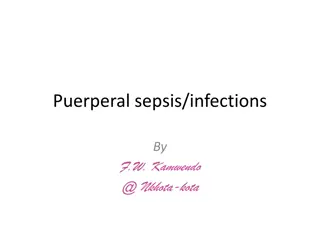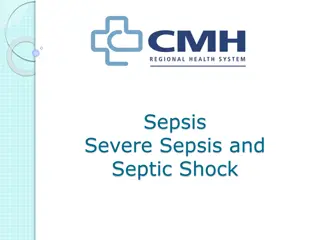DERMATOLOGY AND RHEUMATOLOGY
Staphylococcal Scalded Skin Syndrome (SSSS) is a serious condition characterized by red blistering skin resembling burns. It is caused by toxins from Staphylococcus aureus, leading to exfoliation of the skin. Common in infants, the elderly, and immunocompromised individuals, SSSS requires prompt dia
0 views • 89 slides
Sepsis: Current Management Strategies and Global Efforts
Sepsis is a life-threatening infectious illness with significant global impact. The World Sepsis Declaration of 2012 underscores the need for improved recognition, prevention, and treatment strategies to address the high burden of sepsis worldwide. Efforts are being made to enhance management guidel
4 views • 118 slides
Risks and Strategies for Safe Caesarean Deliveries in South Africa
Understanding the mortality burden related to caesarean deliveries (CD) in South Africa, this report highlights the need for safe CD practices amidst high maternal death rates. Factors influencing safe CD, checklists for accreditation, and strategies for action plans are discussed. The Case Fatality
1 views • 40 slides
Case Study: Sepsis Presentation and Management in Two Patients
Mrs. NP, a 55-year-old woman with a background of cirrhosis from heavy alcohol use, presented to the ED with symptoms suggestive of sepsis. Examination revealed a febrile state, elevated blood pressure, and altered mental status. Investigations were initiated to determine the cause, with differentia
2 views • 41 slides
Enhancing Pediatric Care with the Irish Paediatric Early Warning System (PEWS)
The Irish Paediatric Early Warning System (PEWS) has been updated to align with National Sepsis Guidance in May 2023. It aims to assist in recognizing and responding to deterioration in pediatric patients, emphasizing the importance of clinical judgment and individualized assessment. PEWS does not r
1 views • 41 slides
Early Vasopressors in Sepsis Clinical Trial: Improving Patient Outcomes
This UK-wide clinical trial aims to assess the effectiveness of early peripheral norepinephrine infusion in adult patients with septic shock. The study will compare the impact on mortality and other outcomes of targeting a mean arterial pressure (MAP) above 65mmHg within the first 48 hours of admiss
1 views • 9 slides
Sepsis Risk Awareness Tool (RAT) Training Program Overview
The Sepsis Risk Awareness Tool (RAT) training program by The Virginia Department of Behavioral Health and Developmental Services aims to educate support coordinators, DSPs, and caregivers about the risk factors, signs, and symptoms of sepsis. It covers definitions, risk factors, signs, symptoms, dia
5 views • 22 slides
National Audit Results for Severe Sepsis and Septic Shock 2016/17
This presentation outlines the national results of a clinical audit conducted in 2016/17 regarding the management of severe sepsis and septic shock in Emergency Departments (EDs). The audit objectives include benchmarking current performance, facilitating national and peer comparisons, identifying a
0 views • 25 slides
Overview of Acute Pyelonephritis: Diagnosis, Treatment, and Epidemiology
Acute pyelonephritis is a serious bacterial infection of the kidneys, leading to complications such as renal scarring and sepsis. This overview covers key aspects including epidemiology, etiology, clinical presentations, and risk factors. Diagnosis, treatment, and prevention strategies are also disc
0 views • 18 slides
Collaborating to Combat Sepsis: Role of Respiratory Therapists
Sepsis is a critical condition involving infection and inflammation, where the body's response causes widespread symptoms. Learn about the continuum of sepsis, its pathophysiology, and respiratory warning signs. Respiratory therapists play a crucial role in identifying and managing sepsis, with stat
1 views • 14 slides
Implementation of UCLA Sepsis BPA Functionality & Careplan
The UCLA Sepsis Best Practice Alert (BPA) system aids in creating timely and effective care plans for patients diagnosed with sepsis. This comprehensive guide covers the activation triggers, BPA location, creation process, and elements of the Sepsis Careplan, emphasizing the importance of early inte
1 views • 16 slides
Early-Onset Sepsis (EOS) Risk Factors and Management in Newborns
Neonatal Early-Onset Sepsis (EOS) is a rare but life-threatening condition primarily caused by Group B Streptococcus (GBS) or Escherichia coli. Recognizing risk factors such as maternal age, intrapartum fever, GBS colonization, and certain neonatal characteristics is crucial for timely evaluation an
0 views • 26 slides
Improving Sepsis Care Pathways: Rob's Story Highlights Areas for Enhancement
Rob's journey through a sub-optimal sepsis care pathway sheds light on crucial areas for improvement, such as insufficient education, poor communication, tracking issues, and serious implications leading to family distress and legal challenges. The story emphasizes the importance of timely and effec
1 views • 11 slides
Prevention and Management of Puerperal Sepsis and Infections
Puerperal sepsis and infections are serious conditions affecting women postpartum. Puerperal sepsis is characterized by specific symptoms, while puerperal infections are more general. Prevention includes antenatal care, strict intrapartum hygiene practices, and timely interventions. By following gui
2 views • 8 slides
Managing Complications in Postpartum Period: Puerperal Sepsis Overview
Puerperal sepsis, a leading cause of maternal death, can be prevented through hygiene practices and early identification. Learn about the risk factors, diagnosis, and prevention strategies for maternal sepsis in the postpartum period.
3 views • 9 slides
Biomarker-Guided Antibiotic Duration in Sepsis Patients
This research focuses on evaluating the safety and efficacy of a biomarker-guided approach to determine the duration of antibiotic treatment in hospitalized adult patients with sepsis. The study involves a multi-centre randomized controlled trial to assess if a treatment protocol based on monitoring
0 views • 53 slides
Sepsis and Its Impact on Patient Care
Sepsis is a life-threatening condition resulting from the body's response to an infection, leading to shock, multiple organ failure, and potentially death if left untreated. Recognizing and treating sepsis promptly is crucial, as it has a high mortality rate and can have a significant impact on pati
1 views • 21 slides
Preventing Sepsis: Vital Information for Caregivers
Sepsis is a life-threatening condition caused by the body's response to infection. Learn about the symptoms, prevention strategies, and how to recognize and respond to sepsis in a healthcare setting. The importance of reporting vital signs accurately and understanding patient behavior is also highli
1 views • 9 slides
Ignaz Semmelweis and the Fight Against Puerperal Fever
Ignaz Semmelweis, a pioneer in antiseptic procedures, determined the cause of puerperal fever in the 19th century. His work led to a significant reduction in maternal mortality by identifying the importance of handwashing in healthcare settings. Puerperal fever, a common cause of death in women afte
0 views • 29 slides
Implementation of Sepsis Management Guidelines at Roscommon University Hospital
Sepsis, a life-threatening condition, necessitates timely management for improved outcomes. Roscommon University Hospital implemented the Sepsis Screening Program in 2016 with the objective of standardizing practices, educating teams, and assessing outcomes. The initiative includes training, tool im
1 views • 18 slides
Importance of Vaccinations in Sepsis Prevention
Sepsis is a life-threatening response to infection that can lead to organ failure and death. Infection prevention through vaccinations is crucial to combat sepsis. Best practices include obtaining vaccination consent, offering education, and co-administering vaccines to older adults. Accessing vacci
1 views • 8 slides
Contrasting Pathways in Sepsis Care: Rob's Journey
Rob's story illustrates the stark contrast between sub-optimal and optimal pathways in managing sepsis. Delayed recognition and treatment in the sub-optimal pathway led to severe complications, whereas timely intervention in the optimal pathway resulted in improved outcomes. The importance of early
1 views • 7 slides
Sepsis Fallout Presentation - Managing Severe Sepsis and Septic Shock
This presentation template guides healthcare professionals on effectively managing severe sepsis and septic shock cases, emphasizing prompt recognition and appropriate interventions. It includes sections on patient background, sepsis criteria, treatment protocols, and debriefing discussions for cont
0 views • 7 slides
Improving Mortality Rates in Sepsis Patients: A Clinical Nurse Specialist Initiative
Clinical Nurse Specialist, Mary Lawanson-Nichols, initiated a program at UCLA-Santa Monica Medical Center to reduce mortality rates in sepsis patients. By focusing on mentoring skills, leadership development for staff nurses, and examining influences on mortality, the program aims to make a signific
0 views • 24 slides
Paediatric Emergency Medicine Overview: Infections, Sepsis, Exanthemata, and Warning Signs
Paediatric emergency medicine involves assessing and managing various conditions in children, such as infections, sepsis, and exanthemata. This overview covers the evaluation of febrile children, warning signs indicating potential serious illness, and the importance of thorough examination and asses
0 views • 48 slides
Case Study: Infant with Persistent Fever and Cry
Aditi Malakar, a 2-month-old female infant, presented with a remittent fever persisting for 9 days unresponsive to antipyretics, along with persistent crying and decreased feeding for the last 2 days. She was referred to the hospital after being diagnosed with sepsis elsewhere. Aditi had a history o
0 views • 31 slides
Management Strategies for Pediatric Septic Shock Simulation Program
This content provides information on the management of sepsis, including recognition, supportive care, source control, antibiotics, and specific therapies. It emphasizes the importance of initial resuscitation goals, strategies involving fluid resuscitation, inotropic support, and timely administrat
0 views • 12 slides
Anorexia Nervosa, Bulimia Nervosa, and Post-Partum Psychiatric Disorders
Anorexia nervosa is characterized by significant weight loss, fear of gaining weight, and disturbed body image. It predominantly affects women in adolescence, often associated with dieting and harmful behaviors. Diagnosis involves criteria such as weight loss and amenorrhea. Complications include em
0 views • 14 slides
Updates and Highlights in FY2017 ICD-10-CM/PCS
In the FY2017 update of ICD-10-CM/PCS, significant changes have been made with new codes, updates, and deletions affecting coding diagnoses. The update includes coding highlights related to various conditions like bacteriuria, sepsis, pre-diabetes, and Zika virus. The Third International Consensus D
0 views • 30 slides
Sepsis, Severe Sepsis, and Septic Shock
Body's harmful systemic responses to infection as explained by Dr. M. Farahbakhsh, Assistant Professor of Infectious Diseases at Shahid Beheshti Medical University. Sepsis can progress to severe sepsis with acute organ dysfunction, and further to septic shock marked by hypotension not responding to
1 views • 90 slides
Improving Sepsis Awareness: A Patient Information Initiative
This content delves into strategies to enhance public awareness of sepsis, aiming to provide informative leaflets to patients during discharge from the Emergency Department. It discusses the importance of recognizing sepsis symptoms and outlines a conceptual plan to educate both patients and healthc
0 views • 8 slides
CDI and Coding Considerations
The content delves into crucial aspects of CDI and coding, discussing the evolving definitions of sepsis, SIRS criteria validity, septic shock differentiation, and documentation requirements for sepsis cases. Emphasizing the clinical significance and coding guidelines, it sheds light on probable, po
0 views • 41 slides
Effectiveness of Gentian Violet Cord Care in Preventing Umbilical Cord Sepsis
This study compares the effectiveness of Gentian Violet cord care versus standard air-dry cord care in preventing umbilical cord sepsis among newborns at Port Moresby General Hospital, Papua New Guinea. The aim is to reduce neonatal mortality associated with neonatal cord sepsis.
2 views • 19 slides
Sepsis Study FY2020
The Sepsis Study FY2020 conducted by VHA EPRP under the leadership of Sharon Miller focuses on the SEP-1 measure, early management bundle for severe sepsis, and septic shock. It delves into interventions including lactate measurement, blood cultures, antibiotic administration, fluid resuscitation, a
0 views • 112 slides
IGNAZ SEMMELWEIS AND THE DETERMINATION OF THE CAUSE OF PUERPERAL FEVER
Ignaz Semmelweis, a pioneer in antiseptic procedures, unraveled the cause of puerperal fever in the 18th century, significantly reducing maternal mortality. His work on hygiene and infection control laid the foundation for modern healthcare practices. Through meticulous data analysis, Semmelweis ide
0 views • 29 slides
Developing Service Pathways for Biliary Sepsis Management
Mrs. RH, a pensioner, faced delays in treatment for biliary sepsis due to scheduling issues at the hospital. This case study highlights the implications of such delays, including prolonged hospital stays, increased infection risks, patient anxiety, and care disruptions. Learn about the critical natu
0 views • 24 slides
Core Nursing Education
Sepsis Prevention and Optimization of Therapy (SPOT) is a crucial application in healthcare that monitors patient labs and vitals in real time to identify those at risk of sepsis, offering early intervention for better outcomes. Learn how SPOT works, its impact on nurse workflow, and its role in imp
0 views • 25 slides
Guidelines for Coding Sepsis with Organ Dysfunction
When coding sepsis with organ dysfunction, it is essential for provider documentation to explicitly link the two conditions in order to assign the severe sepsis code. The "with" guidelines dictate that a causal relationship should be assumed unless stated otherwise, but exceptions exist where specif
0 views • 8 slides
Surviving Sepsis Campaign at Cork University Hospital
The Surviving Sepsis Campaign at Cork University Hospital aims to reduce mortality from Severe Sepsis worldwide through a joint collaborative effort of the Society of Critical Care Medicine and the European Society of Intensive Care Medicine. Participating hospitals gain access to educational progra
0 views • 25 slides
Group Sepsis Lead in South/South West Hospitals Group Based in Cork
Sinead Horgan is the Group Sepsis Lead for the South/South West Hospitals Group in Cork. She supports the implementation of the National Clinical Guideline on Sepsis Management across multiple hospitals in the area. This includes hospitals in Cork, Kerry, Waterford, Tipperary, and Kilkenny. Sinead w
0 views • 4 slides







































